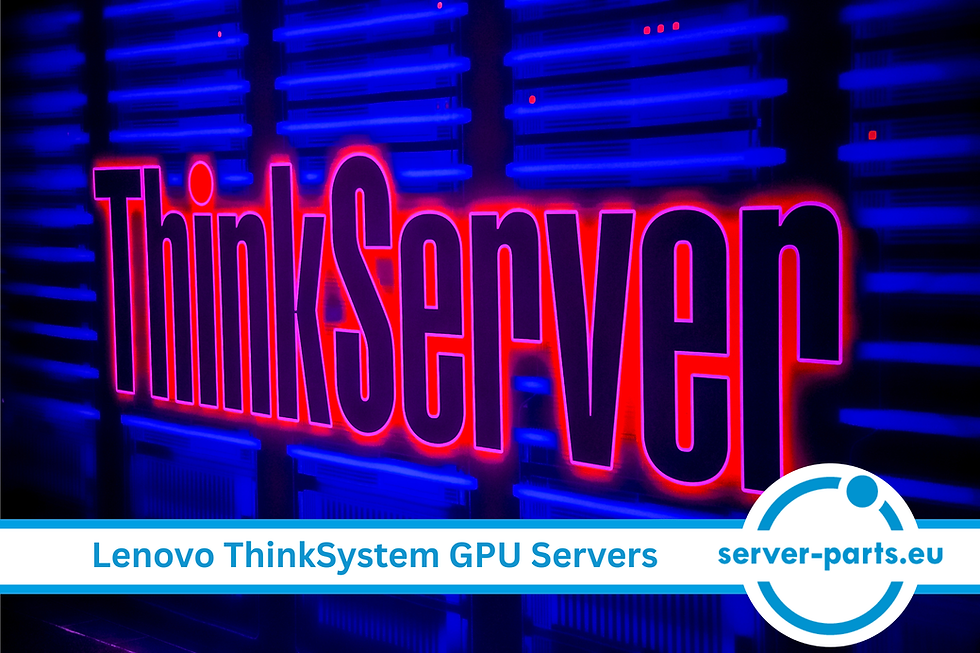SPECIAL OFFER: New Dell PowerEdge R760 with Xeon Gold 6414U and 240TB SAS SSD
- server-parts.eu server-parts.eu

- Aug 5
- 4 min read
Updated: Oct 8
Dell PowerEdge R760 System Overview
Dell PowerEdge R760 | Details |
CPU | 1x Intel Xeon Gold 6414U – 32 cores / 64 threads, 250W, DDR5-4800 support |
Memory | 16x 32GB RDIMM DDR5-5600MT/s (Total: 512GB RAM) |
Storage | 16x 15.36TB SAS SSDs (Kioxia PM7-R, 24G Read Intensive) – Total: 245.76TB |
RAID Controller | PERC H755 SAS Front |
Chassis | 2.5" Chassis with 24 SAS/SATA bays, 4 universal NVMe Direct slots |
Power Supplies | Dual 1100W Hot-Plug Redundant (1+1), Titanium efficiency |
Networking | 2x Intel E810-XXV Dual Port 10/25GbE (OCP 3.0 + PCIe LP adapter) |
Management | iDRAC9 Datacenter 16G with OpenManage Enterprise Advanced Plus |
OS Boot | BOSS-N1 controller with 2x 480GB M.2 drives (RAID 1) |
Cooling | 6x High Performance Fans |
Rails | ReadyRails Sliding Rails (B21) |
Support | 3-Year ProSupport + Keep Your Hard Drive service |
Special Offer: Dell PowerEdge Server R760
✔️ No Upfront Payment Required - Test First, Pay Later!
Processor Architecture - Dell PowerEdge R760
Intel Xeon Gold 6414U is a single-socket SKU (U‑suffix indicates one-CPU board used). It retains support for DDR5‑4800 and up to ~80 PCIe Gen5 lanes via the chip for device expansion—even without a second CPU.
Hardware accelerators (such as QAT, DSA, Crypto, AMX/AVX‑512) are enabled via CPU microcode. The 8‑channel memory layout at 5600 MT/s per Intel spec is enabled when single‑rank modules are used, but this configuration (dual‑rank ×2 per channel) will likely fall back to 4400 MT/s or 4800 MT/s operation. Final frequency depends on UEFI and iDRAC firmware levels.
Memory Subsystem - Dell PowerEdge R760
16 DDR5 RDIMMs populate two DIMMs on each of eight memory channels. This layout maximizes capacity (512 GB) while preserving high theoretical bandwidth.
Because dual‑rank modules are each equally populated, memory interleave remains eight‑channel wide with efficient channel symmetry per CPU.
The 512 GB capacity supports memory-intensive tasks: large VMs, database buffer pools, caching layers, or in-memory analytics.
Storage Backplane and Drive Array - Dell PowerEdge R760
The 2.5″ drive chassis supports 24 universal drive connectors (capable of SAS4, SATA, or NVMe). This system includes 16 fully modern SAS4 drives.
Each Kioxia PM7‑R SSD presents dual 24 Gb/s SAS links. Under PERC H755 control, supporting up to 16 SAS devices with RAID levels up to 60. Best suited for read-heavy jobs (sequential and random) with 1 DWPD rating.
RAID configuration defaults to "unconfigured," which allows cluster or OS layer to use raw devices directly, or software-defined controllers.
If RAID is needed, H755 handles batteryless cache and publicly listed RAID setups (RAID 0, 1, 5, 6, 10, 50, 60) with predictive failure heat maps and SSD retirement warnings.
OS Boot via BOSS‑N1 Module - Dell PowerEdge R760
Onboard Boot Optimized Storage Solution (BOSS‑N1) places two mirrored 480 GB M.2 NVMe drives in RAID‑1 with hot‑swap support.
This arrangement avoids sharing lanes with SAS drives, dedicating PCIe Gen3 ×4 per NVMe device.
In case of one drive failure, the other continues to serve the OS image; insertion of a replacement triggers automatic rebuild.
Network and Expansion Lane Allocation - Dell PowerEdge R760
Networking is handled via an Intel E810‑XXV adapter spanning 10/25 GbE. Ports split via OCP 3.0 mezzanine and additional low-profile card.
Riser config #9 enables three Gen5 ×8 FH/FL slots and one Gen4 ×16 LP slot. With this CPU, multiple GPUs or 100 GbE cards can share lanes without oversubscription.
This lane layout supports future installation of high-speed network adapters, storage DPUs, or compute accelerators without rewiring backplanes.
Cooling, Power Supply and Thermal Control - Dell PowerEdge R760
Six hot-swap fans are arranged in a Smart Flow pattern—air is routed through the chassis where the front drive cage is partially removed—improving airflow over VRMs and CPU heatsink.
This system supports continuous operation of the 250 W CPU at up to 40 °C ambient.
Dual Titanium-rated 1100 W PSUs operate in hot‑swap N+1 redundancy. If one unit fails, server stays active; alerts are pushed to iDRAC. Replacing a PSU requires no tools.
Firmware and Remote Manageability - Dell PowerEdge R760
iDRAC9 (Datacenter 16 G license) integrates with OpenManage Enterprise Advanced Plus for remote virtual console, virtual media, centralized inventory and firmware update orchestrations.
Redfish APIs and automation scripts can control boot order, power policy, thermal thresholds, and configuration delta rollbacks. Group Manager and Quick Sync are disabled in this setup.
TPM 2.0 V6, UEFI-only mode, Secure Boot and GPT partitions are enforced. BIOS enforcement prevents unauthorized device boot loaders. Firmware-level NV-RAM logs capture lifecycle events.
Deployability, Maintenance and Field Service - Dell PowerEdge R760
ReadyRails sliding rack rails are included for tool‑free install in 4-post racks.
Storage trays, PSUs, fans and DIMMs are all serviceable without tools or system downtime.
No bezel means no front-panel LED error indicators—server ID LED is used for location identification.
A service contract covers onsite hardware repair within one business day for 36 months, with drive retention policy included.
Intended Workloads - Dell PowerEdge R760
Workload Type | Ability of this Configuration |
VM-KVM / ESXi hosts | 32C/64T CPU + 512 GB memory easily supports multiple VMs per core. |
File‑oriented storage clusters | High-capacity SAS4 SSDs supply sustained read bandwidth (~4 GB/s peak per drive). |
Software‑defined clusters (Ceph, ZFS) | Unconfigured RAID lets cluster software manage device mapping directly. |
Analytics or backup servers | Large SSD pool supports read-heavy scans, dedupe or compressed workflows. |
Future GPU or DPU additions | Riser config and open Gen5 lanes support later installation of 100 GbE or AI cards. |
This configuration is focused on CPU-bound and read‑intensive workloads with full lane usage available for future expansion and firmware-managed security.
Special Offer: Dell PowerEdge Server R760
✔️ No Upfront Payment Required - Test First, Pay Later!






Comments